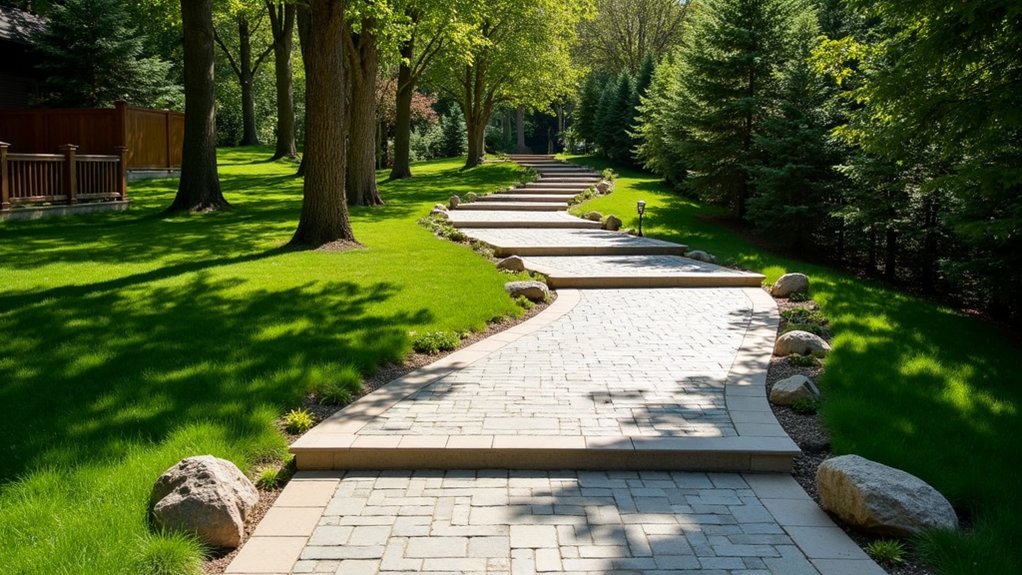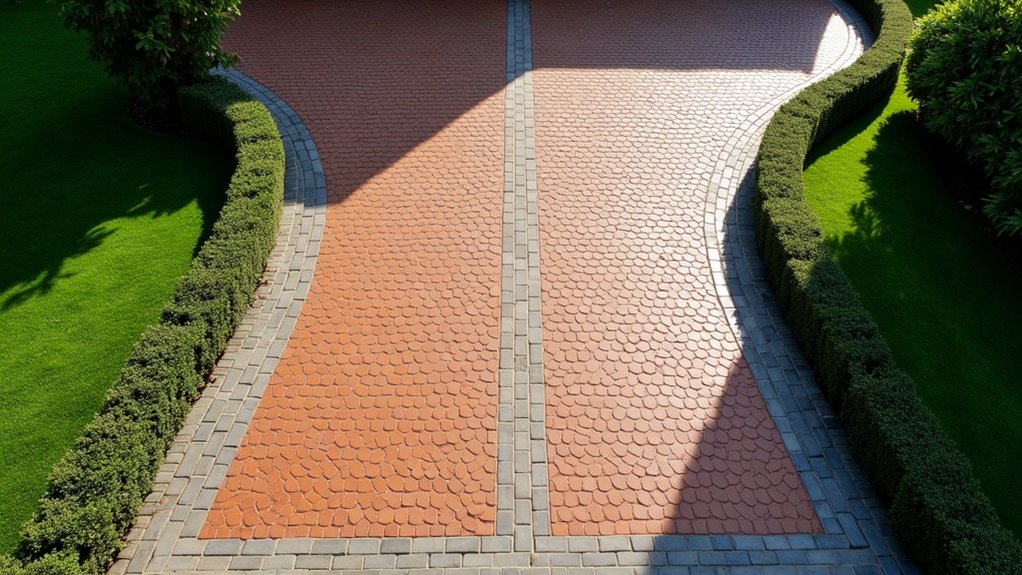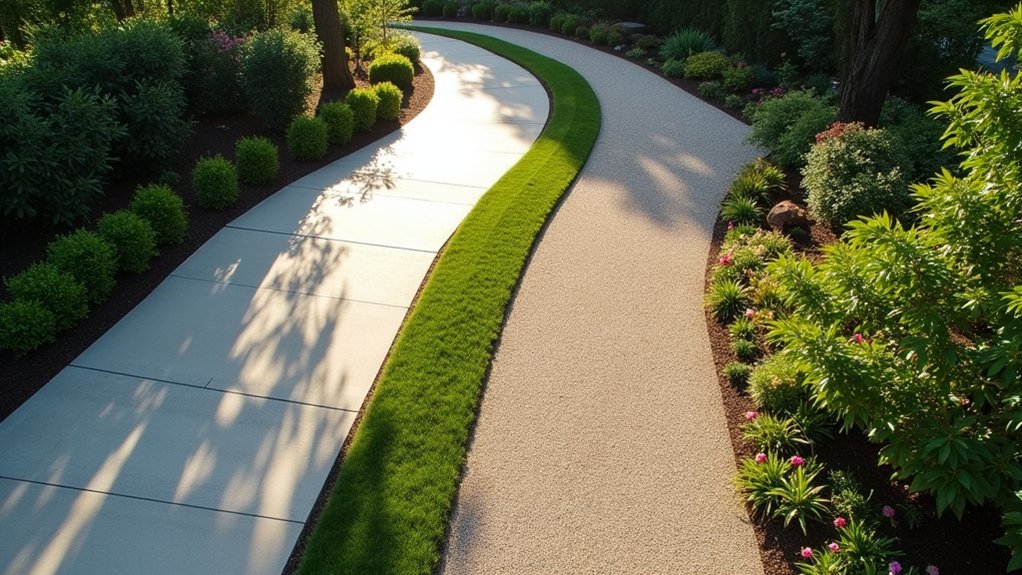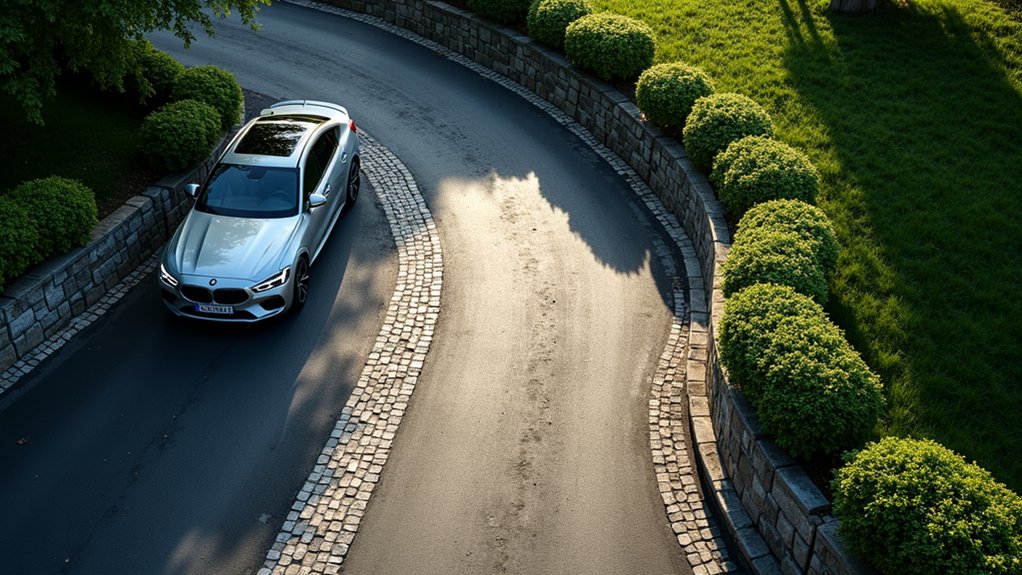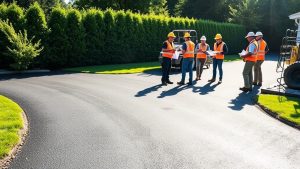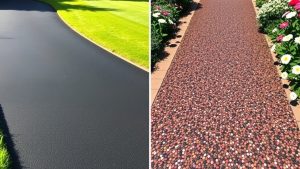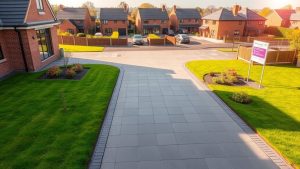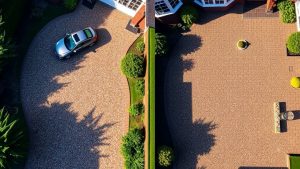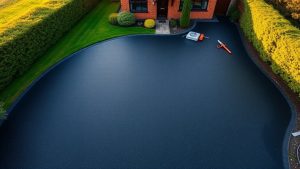When designing a driveway for sloped properties, consider using curved or switchback layouts for improved safety and ease of navigation. Adding a serpentine path not only enhances the visual appeal but also helps manage water runoff effectively. Opt for a minimalist design for a contemporary look, and use a mix of materials to improve traction and drainage. It’s crucial to follow sound construction techniques for stability and prioritise safety features like adequate lighting and anti-slip surfaces. Keep exploring for more insights and innovative ideas for your project.
Table of Contents
ToggleKey Takeaways
- Curved driveways improve safety by reducing the chances of reversing into traffic on steep inclines, making them suitable for vehicles of all sizes.
- Switchback designs are ideal for steep slopes, providing a safe way to ascend and descend while incorporating anti-slip surfaces and appropriate lighting for added security.
- Using permeable pavers alongside gravel enhances traction and drainage, while also allowing for a personalised aesthetic and environmentally friendly options.
- Effective drainage solutions, like channel drains and catch basins, are crucial for managing water runoff and preventing erosion.
- Minimalist styles focus on clean lines and straightforward layouts, boosting curb appeal while remaining functional on sloped properties.
Understanding the Challenges of Sloped Driveways
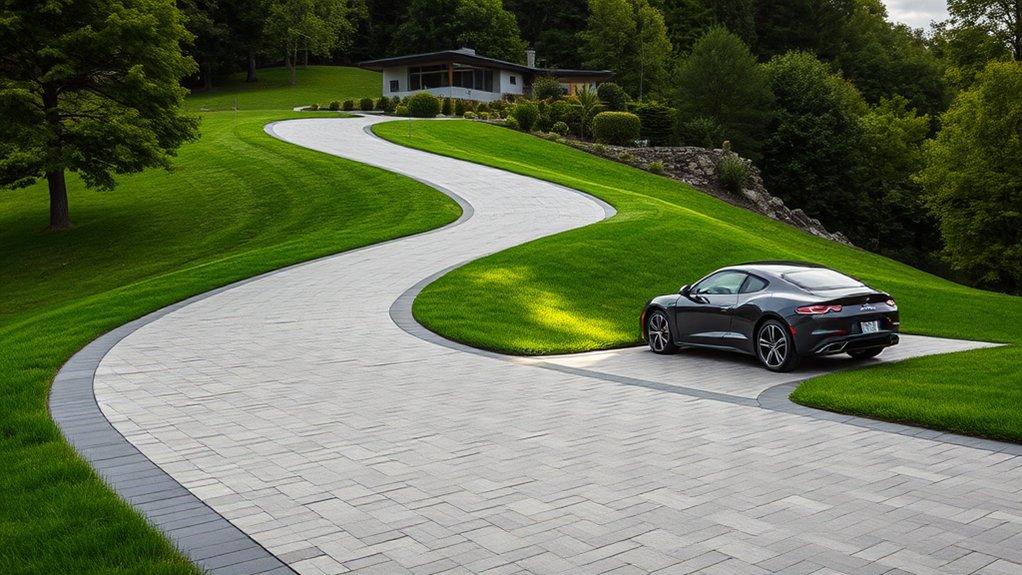
Navigating sloped driveways presents various challenges that can affect both functionality and safety. Over 60% of cross slopes exceed 4 degrees, which complicates slope management and creates accessibility issues, especially for those with disabilities. The importance of proper drainage cannot be overstated, as it helps prevent surface water runoff that can exacerbate erosion and accessibility problems.
The Equality Act recommends keeping cross slopes below 2%, but many driveways fall short, leading to unsafe conditions. Steep cross slopes can push pedestrians into narrow areas, making mobility even more difficult. To ensure usability and safety, it’s vital to manage vertical grade changes carefully, allowing for gradual transitions rather than abrupt shifts. Proper drainage is also crucial to prevent erosion and water pooling, which can worsen accessibility problems. Drainage is critical to prevent pooling and surface damage, enhancing overall safety.
Understanding these aspects is key to designing driveways that are inclusive and safe for everyone.
Curved and Switchback Designs for Enhanced Safety
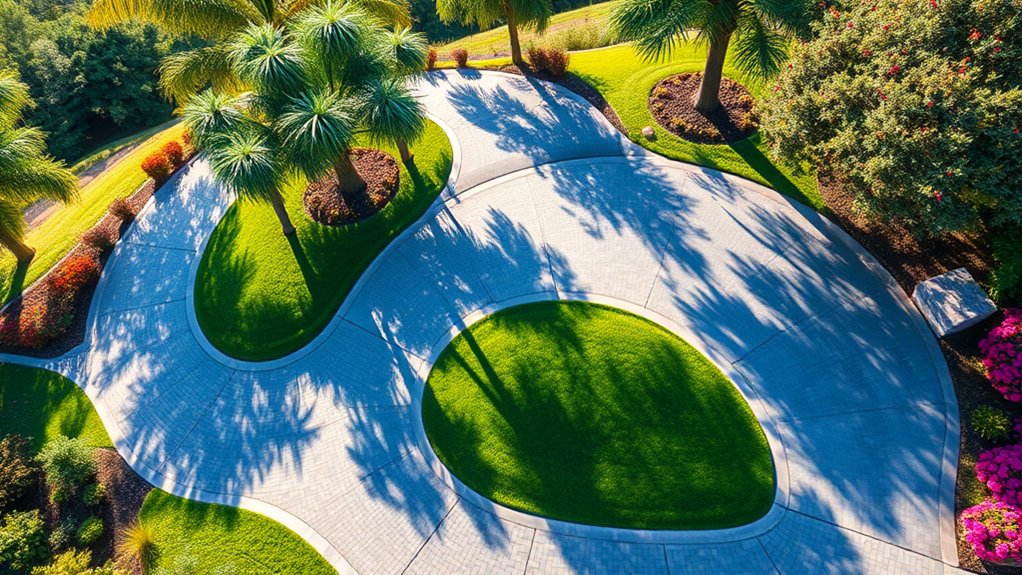
Curved and switchback driveway designs provide effective solutions for navigating sloped properties while improving safety and functionality.
Curved driveways help minimise the risk of reversing into oncoming traffic, allowing for smoother travel on steep gradients. Broad curves ensure that vehicles of all sizes can manoeuvre easily. Driveway layout considerations are crucial when designing these types of driveways to enhance both usability and aesthetic appeal. Additionally, ensuring minimum turning radii accommodates larger vehicles is vital for maintaining safety.
For very steep slopes, switchback designs are essential. They allow for safe ascent and descent, with features like anti-slip surfaces and proper lighting to enhance safety. It’s important to have precise grading and regular maintenance to maintain stability, as improper gradient design can lead to dangerous conditions.
Both designs also offer opportunities for creative landscaping, improving visual appeal while ensuring effective drainage to prevent erosion. With these features, your driveway can be both safe and attractive.
Serpentine Paths: Aesthetic and Functional Benefits
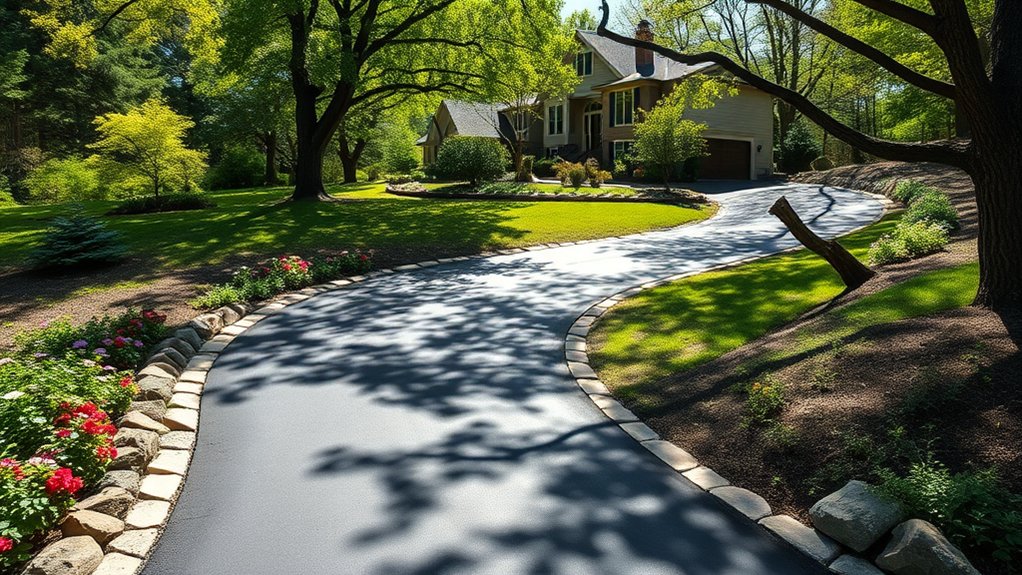
Serpentine paths turn steep slopes into attractive landscapes, softening harsh elevations with their graceful curves. They help control erosion by directing water runoff along the winding route, which reduces concentrated flow and soil displacement. These pathways also offer unique landscaping opportunities, allowing for integrated planting beds and seating areas that enhance both practicality and visual appeal. Additionally, implementing effective drainage solutions within these serpentine designs can further prevent water damage and ensure long-lasting performance. Incorporating sustainable drainage systems into the design can also enhance natural water absorption, further protecting the landscape from erosion.
Visual Softening of Slope
Incorporating serpentine paths into your driveway design can significantly enhance the aesthetics and functionality of sloped properties. These gentle curves soften steep gradients and create a calming visual flow, making the space more inviting. By breaking up straight inclines, serpentine paths harmonise with the natural landscape.
- Curved lines add visual interest, making driveways appear more elegant.
- Plantings alongside the curves introduce texture and colour, boosting curb appeal.
- The meandering layout encourages exploration, enriching the overall experience.
Each gentle turn alleviates concerns about steepness, making navigation safer for drivers. This thoughtful design transforms a challenging slope into an attractive feature that integrates beautifully with your property.
Enhanced Erosion Control
The design of serpentine paths not only enhances the visual appeal of sloped properties but also aids in erosion control. By transforming a straight slope into gentle curves, these pathways effectively slow down water runoff, allowing for better soil absorption and minimising erosion. This natural flow pattern aligns with contour lines, adhering to best practices for erosion prevention.
In addition, using permeable materials alongside these paths can improve stormwater infiltration and reduce concentrated runoff.
Adding vegetated shoulders helps to anchor the soil and preserve nutrient-rich topsoil. Consequently, serpentine driveways not only enhance your landscape but also create a stable and sustainable environment, reducing erosion risks while maintaining your property’s integrity.
Landscaping Opportunities Created
When dealing with sloped properties, serpentine paths not only improve accessibility but also offer a great opportunity for creative landscaping.
These winding driveways help integrate the landscape, blending beauty with ecological benefits.
- Curved paths create spaces for planting beds, boosting biodiversity and visual appeal.
- Retaining walls along these routes help manage soil stability and add design features.
- Resting areas can turn functional driveways into inviting leisure spots.
Embracing Minimalist Styles for Modern Appeal
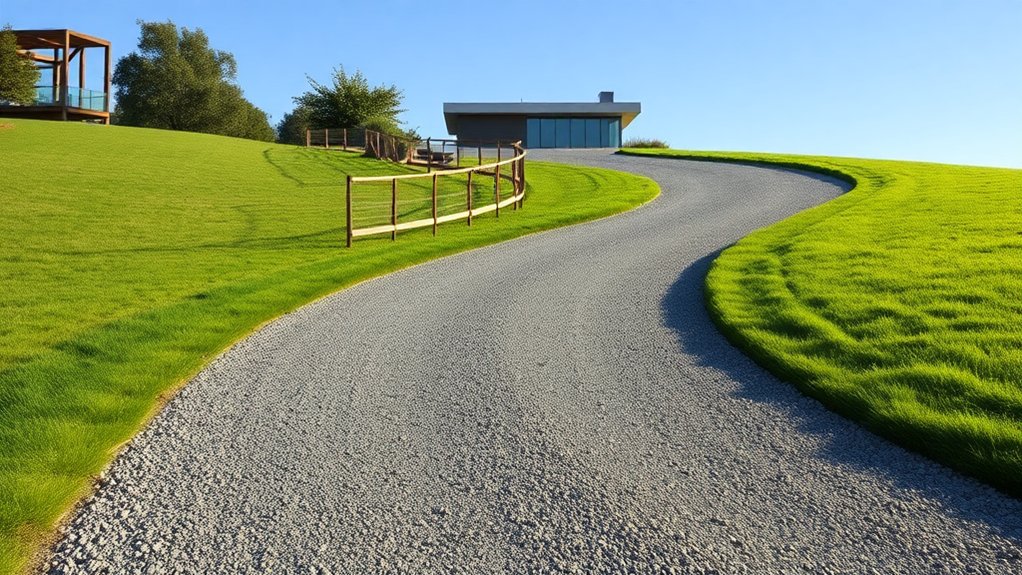
Embracing minimalist styles for sloped driveways can transform them into sleek, modern features that enhance both appearance and practicality. By focusing on simplicity and functionality, you can turn steep slopes into designs that reflect minimalist elegance.
Opt for clean lines and uncluttered layouts to elevate your driveway’s look and make maintenance easier. Smooth concrete slabs or natural limestone pavers offer a polished finish that ages well.
Consider integrating discreet drainage solutions and gentle contours to manage water runoff while maintaining a streamlined design.
Keep landscaping minimal, using low-maintenance plants to frame your driveway. This approach not only enhances curb appeal but also increases your property’s value, creating a stunning and functional entrance to your home.
Choosing Multi-Material Surfaces for Customization
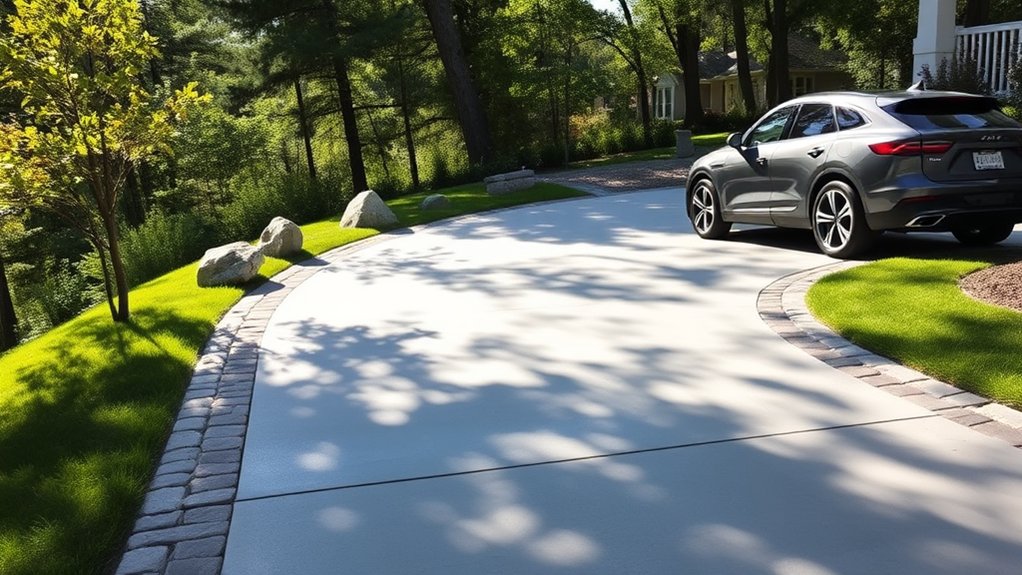
When choosing multi-material surfaces for your sloped driveway, you’re not just improving the look; you’re also boosting functionality.
By combining materials such as permeable pavers and gravel, you can achieve an attractive design that enhances traction and drainage.
This practical approach allows you to tailor your driveway to suit both your aesthetic preferences and practical requirements.
Material Combinations for Aesthetics
Choosing the right material combinations for your driveway not only boosts its visual appeal but also allows for personalisation that reflects your style. Here are some effective combinations:
- Concrete and grass: Using concrete slabs alongside grass pavers softens the hard surfaces and enhances permeability.
- Asphalt and gravel: Mixing asphalt with gravel introduces texture and contrast, providing durability with a rustic feel.
- Brick and cobblestone: Incorporating brick or cobblestone with other materials offers a timeless look and adds character to your property.
These mixed-material surfaces not only improve your driveway’s design but also promote sustainability by enhancing drainage and reducing runoff.
Your choices can significantly influence the overall atmosphere, ensuring your driveway not only stands out but also complements your garden.
Functionality Meets Design Choices
Balancing functionality and design, choosing multi-material surfaces for your sloped driveway can enhance both utility and appearance. By integrating different materials, you can improve the look of your driveway while ensuring it works effectively. Here’s a brief overview of your options:
| Material Type | Benefits | Ideal Use Case |
|---|---|---|
| Permeable Pavers | Excellent drainage, eco-friendly | Steep, busy areas |
| Gravel with Geotextile | Prevents sinking, adds stability | Mild to moderate slopes |
| Interlocking Pavers | Great traction | Icy or steep driveways |
| Concrete/Asphalt Mix | Good grip and manages runoff | High-traffic, varied slopes |
| Recycled Plastic | Sustainable, low maintenance | Durable, eco-friendly choice |
These combinations not only enhance performance but also improve your property’s visual appeal.
Effective Drainage Solutions for Sloped Driveways
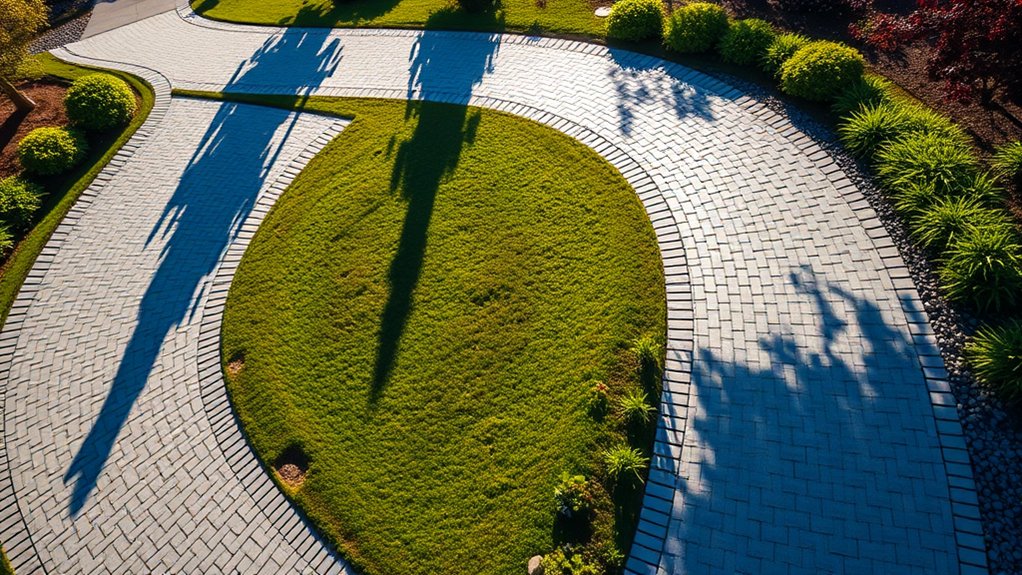
Effective drainage solutions for sloped driveways are crucial for managing water runoff and preventing erosion. Implementing the right drainage systems can significantly improve water management and protect your property.
- Channel and Trench Drains: These are installed directly into the driveway surface to capture water and redirect it away from key areas, such as the foundations of your home.
- Catch Basins and Soakaways: These systems collect runoff and direct it, ensuring that excess water doesn’t overwhelm the surrounding soil.
- Grading and Regrading: Adjusting the slope of your driveway can help channel water away from buildings, reducing the risk of pooling and erosion.
Top Surface Materials for Optimal Performance
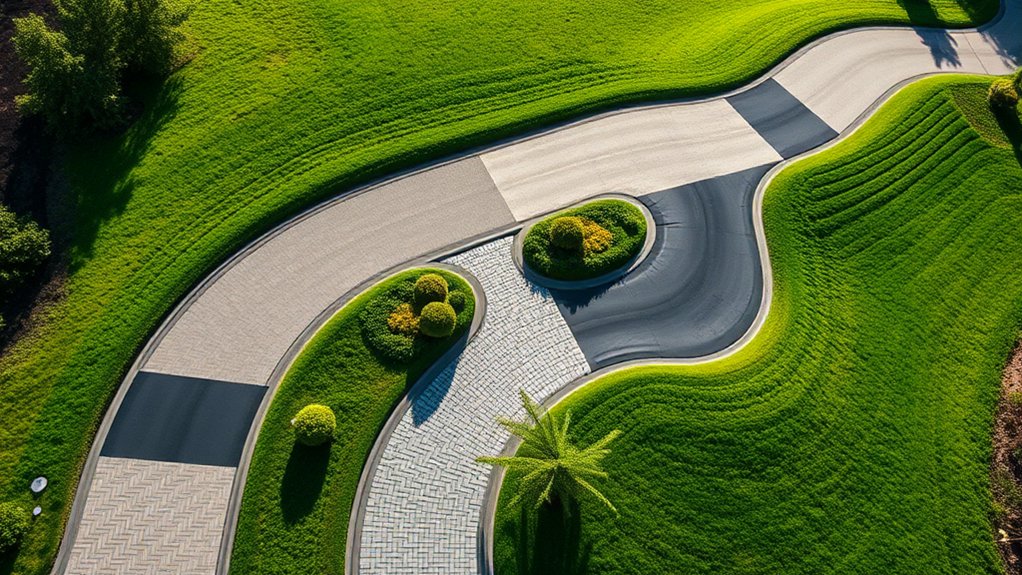
When choosing top surface materials for sloped driveways, it’s crucial to consider performance and durability for optimal functionality.
Permeable plastic pavers are a great option, boasting about 98% water permeability, which helps reduce erosion and can last around 60 years.
For better traction, opt for crushed gravel with jagged edges; this type locks stones in place and prevents slippage on steep gradients.
Asphalt is a budget-friendly choice, offering excellent grip in wet conditions, although it may need regular maintenance.
While pea gravel can enhance the look of gentler slopes, it’s less stable on steeper inclines.
Ultimately, aim for a balance of functionality, durability, and visual appeal to meet your specific driveway needs.
Essential Construction Techniques for Stability
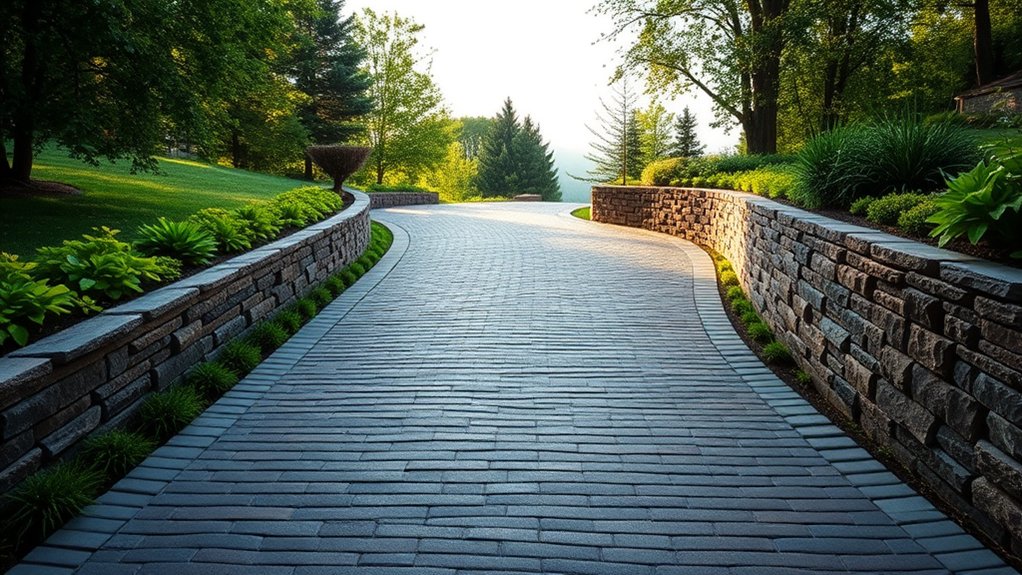
To ensure your sloped driveway endures over time, prioritise compacted base materials for a strong foundation.
Proper drainage solutions are essential to prevent water from pooling, while effective paver installation techniques secure everything in place, minimising erosion and displacement.
Together, these methods create a stable, long-lasting surface capable of withstanding both traffic and the British weather.
Compacted Base Materials
Choosing the right base materials is crucial for ensuring stability in sloped driveway construction, but effective compaction is just as important. Proper layering and compaction are key to creating a solid foundation.
- Opt for compacted aggregates, such as a mix of crushed stone and gravel, to improve durability.
- Aim for a base thickness of 4 to 8 inches to ensure even load distribution.
- Use mechanical compactors to remove air pockets and achieve a firm, stable surface.
Proper Drainage Solutions
Proper drainage solutions are vital for maintaining sloped driveways, as they prevent water build-up and erosion that can affect stability.
Installing channel drain systems at the bottom effectively captures surface water and directs it into pipes, keeping it away from vulnerable areas like garages. When municipal connections aren’t an option, catch basins and dry wells are excellent alternatives for redirecting water.
Retaining walls with drainage features can also channel water efficiently while improving soil stability. For additional protection, consider using diversion channels and water bars to redirect flowing water, helping to minimise erosion.
Permeable paving systems can further assist in managing water by allowing it to infiltrate and reduce runoff. Choosing the right drainage materials will help safeguard your driveway, ensuring it remains durable and effective for years to come.
Paver Installation Techniques
Effective paver installation techniques are crucial for maintaining stability on sloped properties.
Begin by preparing the site: mark boundaries and clear any debris.
Next, focus on base preparation by using geotextile fabric and compacted aggregates to create a solid foundation.
When placing pavers, work from the bottom of the slope upwards and ensure tight fits using a rubber mallet.
Consider these important steps:
- Incorporate drainage systems to effectively manage water runoff.
- Use retaining walls to prevent lateral movement and keep your pavers aligned.
- Regularly apply joint sand to secure the pavers and minimise shifting.
Safety Features to Consider in Sloped Driveway Design
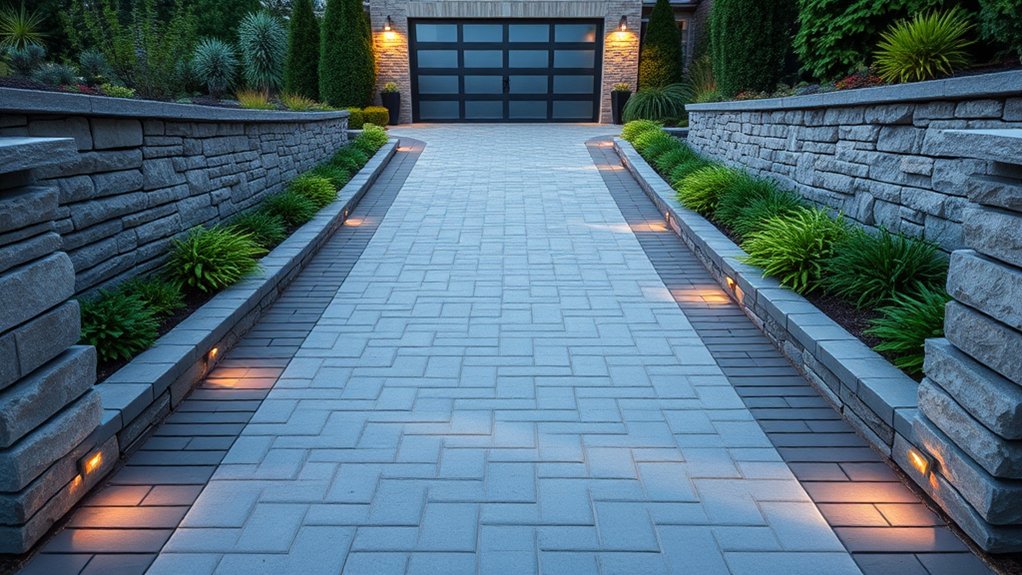
When designing a sloped driveway, it’s crucial to incorporate safety features for functionality and peace of mind. Start by following safety regulations—ensure the slope doesn’t exceed 15–20%. A minimum width of 3.6 metres is recommended to allow access for emergency vehicles.
Using textured concrete or interlocking pavers can enhance traction, helping to prevent slips in wet or icy conditions. Proper drainage systems are vital to prevent erosion, and consider permeable materials to reduce water runoff.
For nighttime safety, install motion-sensor LED lights and ensure clear sightlines. Additionally, smart technologies like heated surfaces or automatic de-icing systems can significantly improve safety in winter.
Enhancing Curb Appeal and Property Value With Design
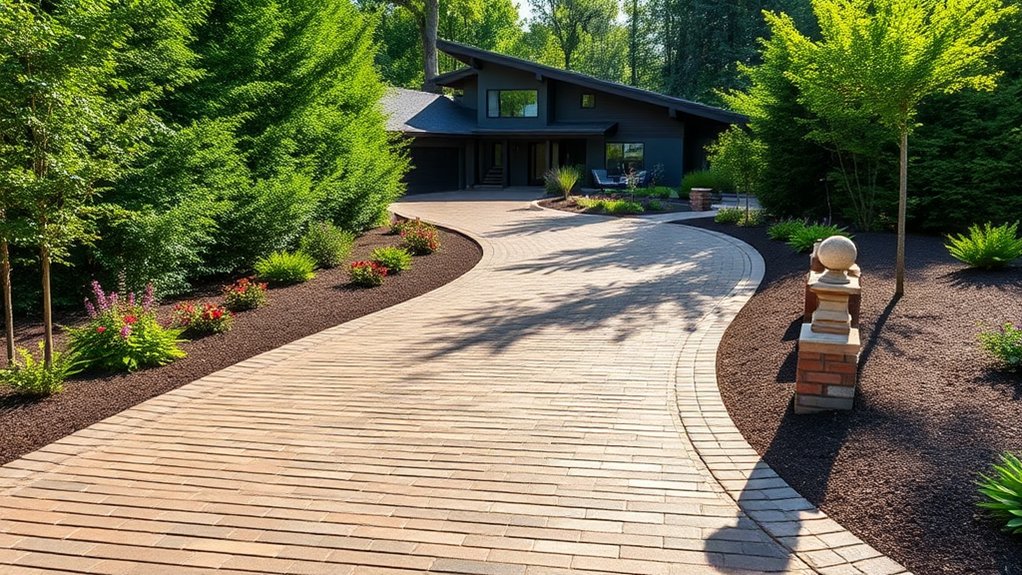
When designing a sloped driveway, you can significantly enhance your property’s curb appeal and market value by choosing the right materials and design elements. Durable options like block paving not only look good but also ensure stability on slopes.
- Consider a curved layout to create an inviting entrance that blends with the natural landscape.
- Use contrasting borders or colours to frame the driveway, drawing attention and enhancing your home’s presentation.
- Add lighting along the edges to showcase design features at night, improving visibility and safety.
These design choices boost visual interest and create a cohesive, appealing environment that potential buyers will find attractive.
Frequently Asked Questions
How Can I Prevent Ice Buildup on My Sloped Driveway?
To prevent ice from forming on your sloped driveway, ensure you have good drainage to direct water away. Applying ice melt before any snowfall can also help. Regular maintenance is key to keeping it safe and reducing slippery spots that could cause accidents.
What Maintenance Is Required for Permeable Paving Surfaces?
Your permeable paving acts like a sponge and requires regular maintenance. Here are some straightforward tips: inspect and clean the surfaces twice a year, give them a good sweep to remove debris, vacuum them annually, and ensure the joint aggregates are well managed. This will help maintain proper drainage and extend the life of your paving.
Are There Specific Permits Needed for Sloped Driveway Construction?
For constructing a sloped driveway, you’ll need specific permits that comply with local regulations. It’s important to submit detailed plans for approval, ensuring they meet requirements related to grading, structural safety, and any potential effects on nearby landscaping. For example, if your driveway leads directly onto a public road, you might need to consider drainage solutions to prevent water runoff affecting the street.
How Can Landscaping Improve My Sloped Driveway’s Drainage?
Picture your driveway surrounded by thriving greenery. By implementing effective drainage solutions and proper landscape grading, you can improve water flow management, minimise runoff, and create an attractive, functional space that works well with the slope. For example, installing French drains or permeable paving can help channel excess water away, ensuring your driveway remains safe and usable.
What Are the Costs Associated With Sloped Driveway Installation?
When considering the costs of installing a sloped driveway, you’ll find that concrete typically ranges from £30 to £60 per square metre, while asphalt costs between £25 and £50 per square metre. Gravel is the most economical choice, costing around £10 to £20 per square metre.
Conclusion
Choosing the right design for your sloped driveway is crucial for both safety and visual appeal. Opt for curved paths to create a smooth transition, and consider minimalist styles for a modern look. Using a mix of materials, such as gravel and paving slabs, can enhance functionality while adding character. Ensuring proper drainage and incorporating safety features like handrails will improve stability and give you peace of mind. A well-designed driveway not only boosts your property’s curb appeal but also increases its value, leaving a positive impression on guests. Invest wisely in your driveway to enhance your home’s charm.
Get inspired by the best block paving patterns for driveways that blend style and durability; discover which layout will elevate Read more
Understand the key factors for selecting the ideal driveway design for your property, and discover how to enhance both functionality Read more
Keeping safety and aesthetics in mind, discover which driveway material excels on slopes—your ideal choice might surprise you!

